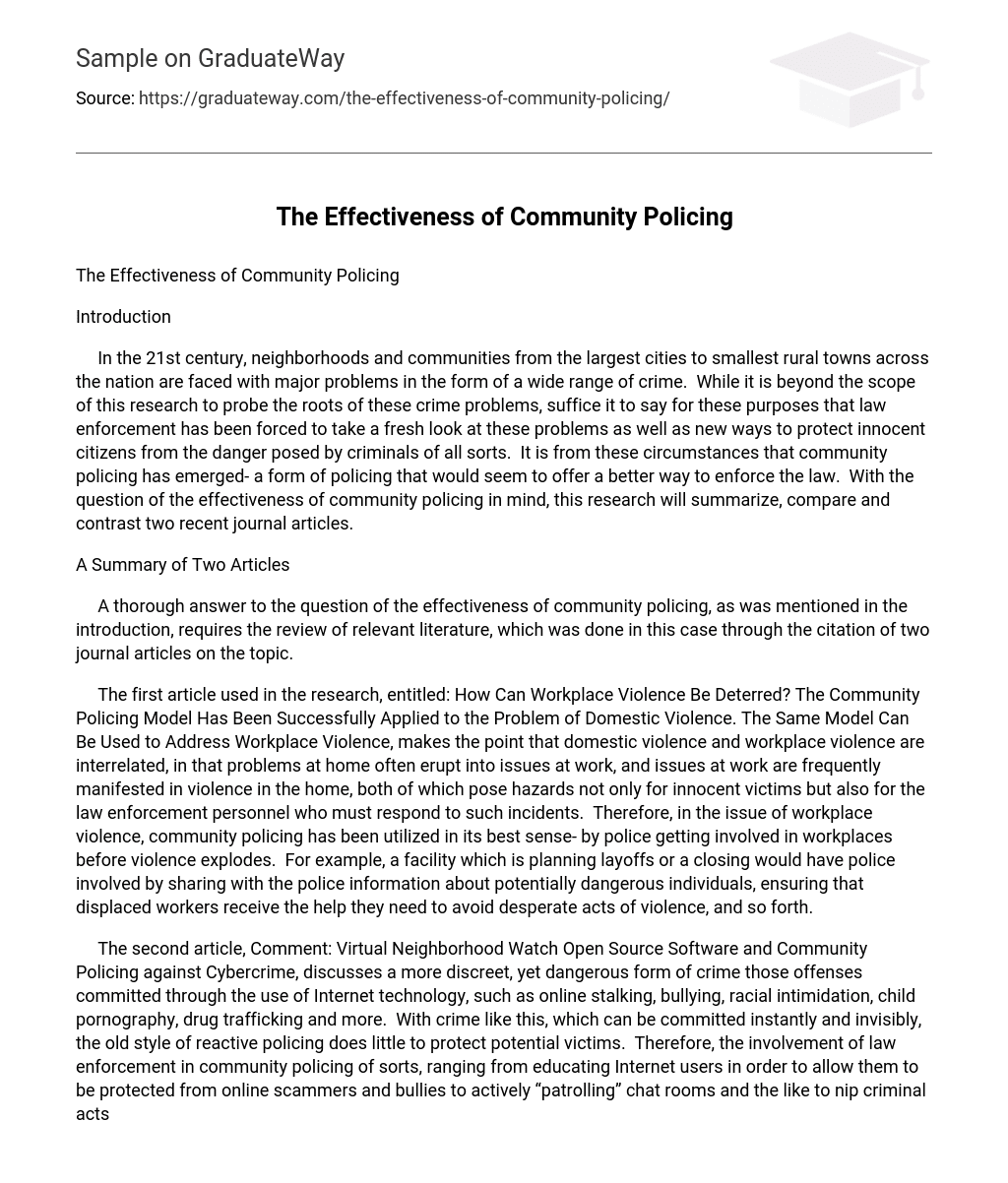Introduction
In the 21st century, neighborhoods and communities from the largest cities to smallest rural towns across the nation are faced with major problems in the form of a wide range of crime. While it is beyond the scope of this research to probe the roots of these crime problems, suffice it to say for these purposes that law enforcement has been forced to take a fresh look at these problems as well as new ways to protect innocent citizens from the danger posed by criminals of all sorts. It is from these circumstances that community policing has emerged- a form of policing that would seem to offer a better way to enforce the law. With the question of the effectiveness of community policing in mind, this research will summarize, compare and contrast two recent journal articles.
A Summary of Two Articles
A thorough answer to the question of the effectiveness of community policing, as was mentioned in the introduction, requires the review of relevant literature, which was done in this case through the citation of two journal articles on the topic.
The first article used in the research, entitled: How Can Workplace Violence Be Deterred? The Community Policing Model Has Been Successfully Applied to the Problem of Domestic Violence. The Same Model Can Be Used to Address Workplace Violence, makes the point that domestic violence and workplace violence are interrelated, in that problems at home often erupt into issues at work, and issues at work are frequently manifested in violence in the home, both of which pose hazards not only for innocent victims but also for the law enforcement personnel who must respond to such incidents. Therefore, in the issue of workplace violence, community policing has been utilized in its best sense- by police getting involved in workplaces before violence explodes. For example, a facility which is planning layoffs or a closing would have police involved by sharing with the police information about potentially dangerous individuals, ensuring that displaced workers receive the help they need to avoid desperate acts of violence, and so forth.
The second article, Comment: Virtual Neighborhood Watch Open Source Software and Community Policing against Cybercrime, discusses a more discreet, yet dangerous form of crime those offenses committed through the use of Internet technology, such as online stalking, bullying, racial intimidation, child pornography, drug trafficking and more. With crime like this, which can be committed instantly and invisibly, the old style of reactive policing does little to protect potential victims. Therefore, the involvement of law enforcement in community policing of sorts, ranging from educating Internet users in order to allow them to be protected from online scammers and bullies to actively “patrolling” chat rooms and the like to nip criminal acts in the bud.
Comparison and Contrast of the Articles
While these articles both reach the same conclusion-that community policing has a vital role to play in modern law enforcement- albeit from two different fronts on the present day war against crime. In one case, law enforcement is able to pinpoint potential trouble spots and take actions to perform a preventative crime fighting role by interacting with the community outright and acting in a way which does everything possible to guard against the kind of workplace violence which has taken hundreds, if not thousands, of innocent lives over the years (Dohery, 2002). This face-to-face, grass roots effort also enhances the reputation of the police in the community, perhaps convincing others that criminal behavior is something that of course is not only against the law, but also to a certain extent culturally unacceptable. It is this type of activity which shows some of the best promise for crime prevention.
On the other hand, the literature which dealt with cyber crime and the community policing of the virtual community so to speak dealt with the activities and interactions of personnel in a world which is not tangible like a brick and mortar town, but real in terms of a breeding ground for crime nonetheless (Jones, 2007). In contrast to the first article, this one showed that there is a unique challenge in the prevention of crime which occurs all around us, but is not able to be seen by even the most skilled police officer, without the use of computers and other high tech equipment.
Despite the differences in these articles, the utility and necessity of community policing shines through in both resources, reinforcing the point that modern criminal activity requires modern thinking and techniques to suppress it.
Conclusion
When this research began, the effectiveness of community policing was a question to be answered; ultimately, through the review of current journal articles on the topic, it was possible to reach the conclusion that given the nature of modern, complex crime, a law enforcement model like community policing is an excellent weapon in the war against crime, offering the possibility of saving countless lives, protecting police officers, and making communities safer for all. Therefore, in conclusion, let it be said that innovation in law enforcement appears to be the tool that is needed at this chaotic time to make sure that civilians and officers alike can stay free of harm and carry on in relative peace.
Works Cited
Dohery, S. (2002, April). How Can Workplace Violence Be Deterred? The Community Policing Model Has Been Successfully Applied to the Problem of Domestic Violence. The Same Model Can Be Used to Address Workplace Violence. Security Management, 46, 134+.
Jones, B. R. (2007). Comment: Virtual Neighborhood Watch Open Source Software and Community Policing against Cybercrime. Journal of Criminal Law and Criminology, 97(2), 601+.





